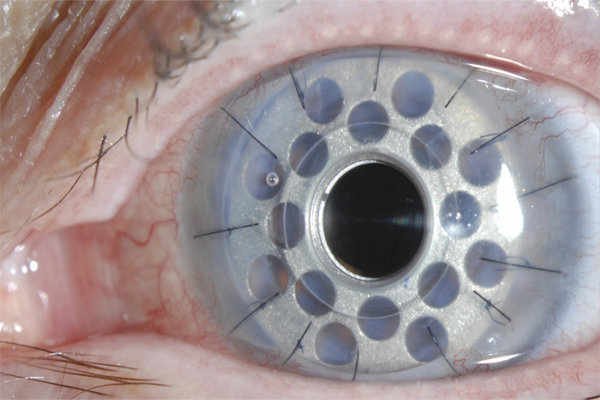In this article, from The Moj Aramesh Amitis Health Tourism Company, we will discuss the cost and results of cornea transplant surgery. We will also answer some frequently asked questions about corneal transplantation.
The Cost of Cornea Transplant Surgery in Iran Compared to Other Countries
Many factors can affect the costs of cornea transplant surgery, including:
- Corneal examination costs
- Surgeon’s fee
- The cost of necessary medications before and after the surgery
- The cost of eye clinic
- The cost of anesthesia

The Eye Bank of Iran is an NGO that collects, processes, and distributes donor corneas among corneal transplant applicants. About 7,000 corneal transplant surgeries are performed annually in Iran. To perform corneal transplant surgery, the cornea is first taken from a donor (deceased person) and screened to check for the absence of infectious diseases. After corneal health is confirmed and screening is performed, the donor’s cornea is transplanted to the patient. The success rate of cornea transplant surgery is approximately 90%. Under appropriate conditions, the cornea can be removed from the donor’s eye up to 24 hours after the donor’s death and transplanted into the eye of the patient. Iran Eye Bank is a leading corneal bank in the Middle East and exports corneal tissue to neighboring countries. Iranian universities of medical science are cooperating with the World Health Organization to diagnose and treat various eye diseases. The cost of corneal transplant surgery in Iran, estimated by The Moj Aramesh Amitis Health Tourism Company, is between $1,100 to $1,450 in different clinics. The cost of cornea transplant surgery in Iran is much lower than in other countries. Iran, with its experienced and skilled surgeons, up-to-date tools, and advanced medical facilities, is a very suitable destination for corneal transplant surgery. Many international patients who are looking for a country to perform their corneal transplant surgery, choose Iran as their destination for corneal transplant surgery.
Results of Cornea Transplant Surgery
The eyesight of most people who undergo corneal transplant surgery is at least partially restored. What you can expect after a corneal transplant surgery depends on the surgeon’s skill and your health status. The risk of complications related to corneal transplant surgery (such as corneal rejection) will persist for years after cornea transplantation surgery. Therefore, visit your eye surgeon regularly. Corneal rejection can often be managed using various drugs (such as immunosuppressive drugs). Cornea transplantation surgery will have different results for different people. Below, one of the most important and main results of cornea transplantation surgery is mentioned.
- Vision Correction After the Surgery
Your vision may initially be worsening after the surgery, as it takes time for the new cornea to adjust to the eye. It may take up to months for your vision to improve. Once the outer layer of the cornea has healed (usually between few weeks to few months), your ophthalmologist will work to make adjustments that can improve your vision, including:
- Correcting unevenness in your cornea (astigmatism):
Stitches attaching the donor’s cornea to your eyes may cause dips and bumps in your cornea and blur your vision. The surgeon can eliminate these problems by releasing some of these stitches and tightening some others.
- Correcting vision problems:
Refractive errors such as myopia and hyperopia can be solved by wearing glasses or contact lenses or sometimes laser eye surgery.
Cornea Transplant Surgery FAQ
If you have just realized that you need corneal transplant surgery, you may have many questions about this surgery in your mind. Keep reading on The Moj Aramesh Amitis Health Tourism Company to learn about some of the most frequently asked questions of applicants for corneal transplant surgery, including:
- What typically happens before cornea transplant surgery?
Your ophthalmologist and the anesthesia team will review your medical history, answer your questions and confirm the surgical plan. The anesthesia team will administer either sedation or general anesthesia depending on your ophthalmologist’s opinion and your medical status. To reduce the pain, the anesthesia team will apply a numbing medication to your eyes. The surgery itself is an outpatient procedure (you will not be staying at the hospital or eye center). The surgery typically takes less than 2 hours to perform. You will not be admitted to a hospital or eye clinic after corneal transplant surgery. However, in some cases, you may also have to be hospitalized to have your condition checked after the surgery (such as checking the risk of corneal rejection).
- What to expect after the cornea transplant surgery?
On the first day of the surgery, your eyes may become irritated or sensitive to light or become red. Typically, pain can be controlled by taking painkillers prescribed by your ophthalmologist. Your eyes will be covered by an eye patch after the surgery. Wear this patch while sleeping or showering. The eye surgeon or medical team will inform you about activities you need to avoid after the surgery (especially any activities that may cause a direct hit to the eyes). Usually, after the surgery, you may have to lie on your back while sleeping. This will help prevent you from putting extra pressure on your eyes. The length of time that you have to lie on your back while sleeping depends on the performed surgical method. Visit your ophthalmologist within 24 to 48 hours after the surgery to check on how your eye is healing. The ophthalmologist will also prescribe various eye drops and ointments to help your eye heal as it examines your healing process. Eye drops and ointments that are prescribed, usually contain both antibiotics (to prevent infection) and corticosteroids (to reduce swelling, inflammation, and prevent corneal rejection). Depending on the type of stitches and the surgical technique used to perform corneal transplant surgery, your eye stitches may need to be removed. If the stitches used for your corneal transplant need to be removed, you should visit your ophthalmologist again a few months after the corneal transplant to remove your stitches. Ophthalmologists usually recommend using regular glasses or protective eyewear for a while after cornea transplant surgery to protect your eyes. While recovering, do not rub or squeeze your eyes. Rubbing or pressing the eye can cause damage to your cornea and interrupt the healing process.
- What are the complications of cornea transplant surgery?
One of the worrying complications of this surgery can be cornea rejection i.e. your immune system may identify the donor’s organ as a foreign object and reject it. Use eye drops for at least a year to decrease the risk of cornea rejection. Corneal transplant surgery, in addition to the possibility of corneal rejection, can also pose other risks for you. In continuation of this article, we have fully discussed some of the risks and complications associated with corneal transplantation surgery.
Other complications of cornea transplant surgery include:
- Infection – in the cornea or inside the eye
- Bleeding
- Glaucoma (increased pressure inside your eye)
- Fluid leakage from your cornea
- Detached retina (tissue lining the back of the eye pulls away from the eye)
- Visual acuity problems (sharpness of the vision) caused by an irregular curve in the shape of the cornea
- Detachment of the corneal transplant (for the endothelial transplant which is held in place by an air bubble)
For most people, a cornea transplant is very successful in the long term. Your surgeon can help you decide if a cornea transplant is right for you.
- Can a cornea transplant be avoided?
The key to avoiding a cornea transplant is to prevent damage or injury to your cornea. If a damaged cornea will not heal using other methods, a cornea transplant may be unavoidable to keep your vision.
- How soon can I drive after a cornea transplant?
You must not drive on the day of your cornea transplant. Someone must drive you home after surgery and bring you back for your follow-up visit.
If you have good vision in the non-transplant eye, you can legally drive 24 hours after surgery. However, your surgeon may recommend waiting longer before driving.
- When can I return to work after a cornea transplant?
It may take a few days to a few weeks before you can return to work. It depends on your level of discomfort, your vision, and what activities you perform at work. Jobs that require strenuous activity such as lifting may need more time off from work.
- When should I call my surgeon?
Contact your surgeon immediately if you experience any signs of cornea rejection, including:
- Eye pain
- Eye redness
- Hazy or cloudy vision
- Sensitivity to light
If you notice any other problems in your vision after a cornea transplant, or you experience symptoms of infection, such as fever, eye drainage, or pain, contact your surgeon.

In this article from The Moj Aramesh Amitis Health Tourism Company, we discussed the frequently asked questions of applicants for corneal transplant surgery, the results of this surgery, and also the costs related to corneal transplant surgery in Iran. Finally, it should be noted that the cost of corneal transplant surgery varies from person to person. In general, the costs associated with corneal transplantation surgery depend on the amount of damage done to the patient’s cornea, the number of corneas needed for transplantation (only one eye or both eyes of the patient may require corneal transplantation surgery), the clinic you choose to perform corneal transplant surgery, and other factors mentioned in this article. If you have a question for your corneal transplant surgery that was not answered in this article, you can go to an ophthalmologist and get the answer to your question.
Author: Sh. Khazaei
Translator: N. Rahimifar




